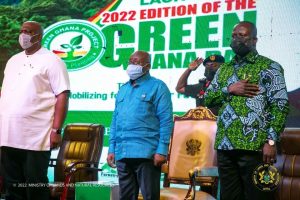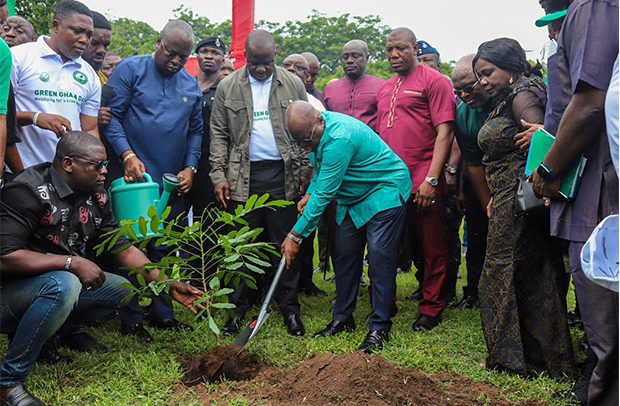President Akufo-Addo planting a tree during one of the Green Ghana Day editions.
CLIMATE CHANGE is one of the most discussed issues around the world today, with the subject featuring in almost every discussion in every sector of the world. Perhaps that could be attributed to how climate change, as experts say, affects almost every part of human life. There is even a belief that climate change would sooner or later, become threat to our very existence as a people, if things continue the way they currently are.
Like every problem of nature, countries and institutions around the world, spring into action with one purpose – to find a solution to it. However, the solutions proffered would vary from country to country and this is largely due to the fact that the impact of climate change also varies on every country.
Some of these impacts [of climate change] include droughts, rise in sea levels (which often leads to the displacement of people), high temperatures (global warming) etc.
The Case of Ghana
Here in Ghana, the discussion has not waned either, even though there is still a chunk of the population – especially those within the lower and middle class – who do not have an appreciable grasp of the topic. Successive governments have put in efforts in combating the impact of the phenomenon on the country by instituting several initiatives; but one boasts of significant attention – the Green Ghana Day.
Green Ghana Day
The Green Ghana Day project was introduced in 2021, by H.E. Nana Addo Dankwa Akuffo-Addo, President of the Republic of Ghana, as part of an aggressive national afforestation/reforestation programme aimed at restoring Ghana’s lost forest/vegetative cover by planting trees. The initiative also has an overarching aim of contributing to global efforts at mitigating climate change.
The maiden edition, held in June 2021 had a target of 5 million trees while the 2022 edition had a target of 20 million trees to be planted. This year’s (2023) edition, which was held under the theme, “Our Forests, Our Health”, had a target of 10 million trees.
Government, through the project, also seeks to create an enhanced national awareness on the necessity of collective action towards restoring the country’s degraded landscape; inculcating into the youth, the values of planting and nurturing trees and its associated benefits; enhancing the livelihoods for rural communities through their engagement in the production of tree seedlings and beautifying the communities and environment.
The project was well received by all Ghanaians home and abroad as evidenced by the huge number of individuals; government and private agencies and organisations; religious groups; security services; non-governmental organisations (NGOs) as well as the diplomatic community in the country, who all have taken turns to plant trees in various parts of the country since the inception of the project in 2021.
Rationale
President Akufo-Addo, at the launch of the 2022 Green Ghana Day in Accra lamented that despite the importance of the forests to human existence, Ghana’s, and in fact the world’s forests, were depleting at an “alarming rate.”
According to him, some 18 years ago, half of the earth’s surface was covered by forest, with an estimated forest area of 4 billion hectares and forest cover being less than 30% of the world’s surface.
Also, globally, some 1.6 billion people depend on the forest for their livelihoods; and in Ghana, some 85% of the population rely on forest resources for subsistence to satisfy their socio-cultural needs.
However, in the last three decades alone, the world has lost 1 billion, 37 million, 846 thousand, 602 arches (1,037,846,602) of the forest – more than 10% of the current total forest area, the President noted.
“More troubling”, he added, “is the current date that shows that globally, we are losing 150 arches of rain forest every single minute; 200,000 arches a day and 79 million a year; and this is just rain forest.”
To deal with this challenging situation, his administration therefore, embarked on the aggressive afforestation and reforestation program dubbed ‘Green Ghana Day’, he said.
Ghana’s Minister for Lands and Natural Resources, Samuel Abu Jinapor, also added that statistics showed that the country had lost some 100,000 arches of natural forest in the last decade alone, stressing on the importance of the project.
Facts and Figures
The Ministry of Lands and Natural Resources, the official government agency spearheading the Green Ghana Day project, announced that even though 5 million trees were targeted in 2021, it exceeded that target with about 7 million trees being planted that year.
“Last year, we raised our ambition and targeted at least, 20 million trees. Again, you supported us, and over 24 million trees were planted; bringing the total planted trees over the years to an excess of 31 million trees”, the Ministry added.
According to the sector minister, field monitoring assessment conducted by the National Intelligence Bureau (NIB) and the Ghana Forestry Commission indicated that about 80% of the over 7 million trees planted across the country in 2021 “have survived so far, and are doing very well.”
For 2022, field assessment report shows that on the average, “we had 72% survival rate last year as compared to the about 80% in 2021”, he said, adding that, while adequate measures were put in place to ensure the full survival of all trees planted, a number of external factors including rainfall patterns, wildfires and soil fertility accounted for the current results.
The minister continued that this year’s target had had to be revised downwards to 10 million trees. This, he explained, was to give his outfit the needed space to devote some resources and attention to the trees planted over the last two years, while not losing momentum on their quest to restore the country’s degraded landscape.
Good Move Dr. Yaw Agyeman Boafo (PhD), Senior Research Fellow (Integrated Ecosystems Assessment & Sustainability Science) at the University of Ghana, Legon, stressed on the importance of having more trees planted, especially in the urban areas as they would provide conducive environments for people to relax and enjoy the natural environment.
“It is very important that we keep planting trees in our urban areas. They are places where people can go sit and relax. And it will promote good health. They can be social health places for relaxation where you know, you go out with your family and sit under a tree and relax.”
Continuation
Figures churned out by the government and it’s agencies are really massive and if they are anything to go by, they do deserve a huge commendation. However, it remains to be seen whether or not the project would be continued by the successive governments given the popular ‘African problem’ of failure of successive governments to continue important projects initiated by a previous government. For the love of humanity and survival, this project needs not end with the passing of the current government but rather continue and even be bettered so as to make our world safe and conducive for all.
This report is produced in fulfilment of the UNESCO and CIJ London Climate Change in News Media project facilitated by the Centre for Journalism Innovation and Development (CJID).

Green Ghana Day was introduced by President Akufo-Addo (middle) as part of government’s efforts at mitigating climate change.

Ghana’s Minister for Lands and Natural Resources, Samuel Abu Jinapor, plants a tree in commemorating Green Ghana Day.

Samuel Abu Jinapor, Minister for Lands and Natural Resources, announced that government sought to plant 10 million trees this year (2023).
By Nii Adjei Mensahfio


